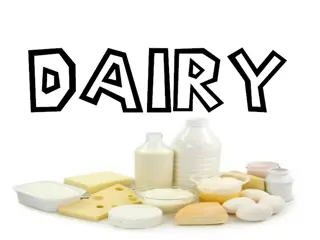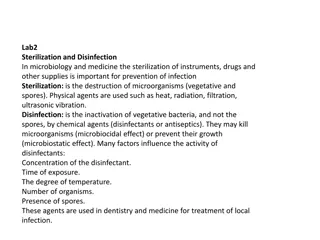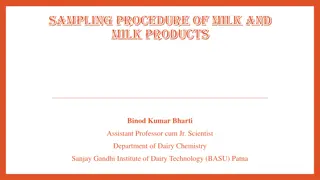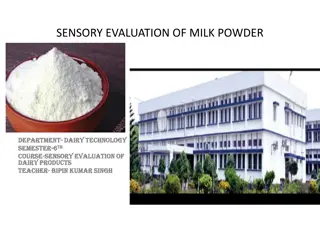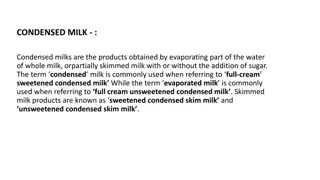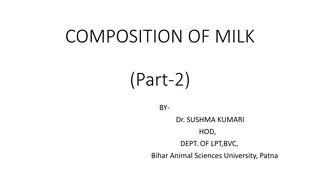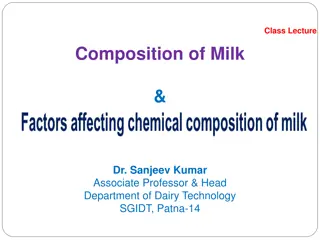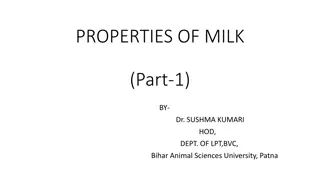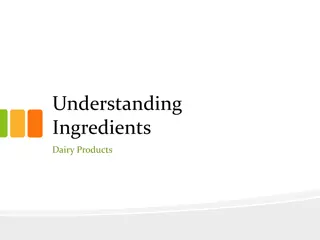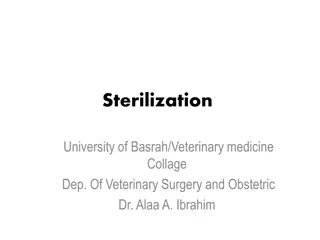Milk Microbiology and Sterilization Techniques
Milk, being virtually sterile in a healthy cow's udder, is prone to bacterial contamination. Learn about sterilization methods like high-temperature sterilization and pasteurization to ensure milk safety. Quality control measures involve organoleptic and clot on boiling tests to detect abnormalities. Explore the importance of quality control in pasteurized milk to adhere to regulations and standards.
Download Presentation

Please find below an Image/Link to download the presentation.
The content on the website is provided AS IS for your information and personal use only. It may not be sold, licensed, or shared on other websites without obtaining consent from the author.If you encounter any issues during the download, it is possible that the publisher has removed the file from their server.
You are allowed to download the files provided on this website for personal or commercial use, subject to the condition that they are used lawfully. All files are the property of their respective owners.
The content on the website is provided AS IS for your information and personal use only. It may not be sold, licensed, or shared on other websites without obtaining consent from the author.
E N D
Presentation Transcript
Milk microbiology
Introduction:- Milk is virtually sterile when it is synthesized in a healthy cow's udder (mammary gland). Cows, like humans, are natural reservoirs of bacteria. Many of these bacteria are not harmful to humans, but some may be harmful to humans even though the cows are not affected and appear healthy.
Sterilization of milk by two method 1-High temperature sterilization The sterilisation of milk is accomplished by heating it up to the boiling point, 2120 F. In a vacuum this may be accomplished by a temperature a few degrees lower . 2-Pasteurization of milk : is a process that kills harmful bacteria by heating milk to a specific temperature for a set period of time.
QUALITY CONTROL OF PASTEURISED MILK : QUALITY CONTROL OF PASTEURISED MILK : Milk quality control is the use of approved tests to ensure the application of approved practices, standards and regulations concerning the milk and milk products
A) Organoleptic tests Procedure: Open a can of milk. Immediately smell the milk. Observe the appearance of the milk. If still unable to make a clear judgement, taste the milk, Look at the can lid and the milk can to check cleanliness
RESULTS Abnormal smell and taste may be caused by: Atmospheric taint (e.g. barny / cowy odor). Physiological taints (hormonal imbalance, cows in late lactation- spontaneous rancidity). Bacterial taints. Chemical taints or discoloring. Advanced acidification (pH < 6.4).
B) Clot on Boiling (C.O.B) Test Procedure: Boil a small amount of milk in a spoon, test tube or other suitable container.
RESULTS If there is clotting, coagulation or precipitation, the milk has failed the test. Heavy contamination in freshly drawn milk cannot be detected, when the acidity is below 0.20-0.26% Lactic acid.
Alcohol test Alcohol test Procedure: The test is done by mixing equal amounts of milk and 68% of ethanol solution in a small bottle or test tube. (68 % Ethanol solution is prepared from 68 mls 96%(absolute) alcohol and 28 mls distilled water).
Result Result If the tested milk is of good quality, there will be no coagulation, clotting or precipitation, but it is necessary to look for small lumps. The first clotting due to acid development can first be seen at 0.21-0.23% Lactic acid
Alcohol Alizarin test Parameter Normal milk Slightly acid milk Acid milk Alkaline milk PH 6.6 -6.7 6.4-6.6 6.3 or lower 6.8 or higher Colour Red Brown Yellowish brown Yellowish Lilac Appearance of milk : No coagulation no lumps No coagulation Coagulation No coagulation
Resazurin test. Resazurin disc no . Colour Grade of milk Action 6 Blue Excellent Accept 5 Light blue Very good Accept 4 3 Purple Purple pink Good Fair Accept Separate 2 Light pink Poor Separate 1 0 Pink White Bad Very bad Reject Reject
Inhibitor test. Inhibitor test. Materials: test tubes Starter culture lml pipette water bath material for determination of titratable acidity Procedure: Three test tubes are filled with l0 ml of sample to be tested and three test tubes filled with normal milk. All tubes are heated to 90 0C by putting them in boiling water for 3 - 5 minutes
R Results esults If acid production in suspected sample is the same as the normal sample, then the suspect sample does not contain any inhibitory substances; If acid production as suspect sample is less than in the normal milk sample, then, the suspect sample contains antibiotics or other inhibitory substances.
The Gerber Butterfat test The Gerber Butterfat test Apparatus for DF test: Gerber butyrameters, 0-6% or 0-8% BF Rubber stoppers for butyrometers 11 ml pipettes for milk 10 mls pippetes or dispensers for Gerber Acid 1 mls pippetes or dispensers for Amyl alcohol stands for butyrometers Gerber water bath Reagents: Gerber sulphuric acid,(1.82 g/cc) Amyl alcohol
Procedure Add 10 mIs sulphuric acid to the butyrometer followed by 10.94 or 11 mls of well mixed milk. Next add 1 ml of Amyl alcohol, insert stopper and shake the butyrometer carefully until the curd dissolves and no white particles can be seen. Place the butyrometer in the water bath at 65 C Spin for 5 min. at ll00 rpm. Remove the butyrometers from the centrifuge. Put the butyrometers in a water bath maintained at 65 C for 3 min. before taking the reading
R Result esult The colour of the fat column should be straw yellow. The ends of the fat column should be clearly and sharply defined. The fat column should be free from specks and sediment. The water just below the fat column should be perfectly clear.
Acidity test Bacteria that normally develop in raw milk produce more or less of lactic acid. In the acidity test the acid is neutralised with 0.1 N Sodium hydroxide and the amount of alkaline is measured.
Alkaline phosphatase test Alkaline phosphatase test Phosphatase (ALP) is an enzyme naturally present in all raw milks, which is used as an indicator of proper milk pasteurization.
Alkaline phosphatase test Alkaline phosphatase test The more enzyme activity present the more phenol is liberated giving a deeper color blue.
Thank You & Good bye ^_^





